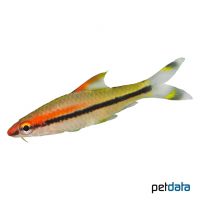Red Line Torpedo Barb (Sahyadria denisonii)
| Red Line Torpedo Barb Sahyadria denisonii | |
|---|---|
| Name | Red Line Torpedo Barb |
| Name Lat. | Sahyadria denisonii |
| Synonym | Puntius denisonii |
| Family | Carps |
| Family lat. | Cyprinidae |
| Order | Carps |
| Order lat. | Cypriniformes |
| Origin | Southern India |
| Habitat | Mountain streams |
| Diet | Omnivore |
| pH | 6.0-8.0 |
| Behavior | Peaceful |
| Keeping | Group |
| Care Level | Moderate |
| Reproduction | Egg scatterer |
| Breeding | Difficult |
| Life Span | 6-10 years |
| Protection | No |
| Metric Units | |
| Size | 15 cm |
| Temperature | 15-25 °C |
| Hardness | 5-25 °dH |
| Aquarium | ~ 350 l |
| US Units | |
| Size | 6" |
| Temperature | 59-77 °F |
| Hardness | 89-445 ppm |
| Aquarium | ~ 90 gal |
Distribution and habitat
Denison's barbs are common in the state of Keral as well as neighboring Karnataka in southern India. They live in mountain streams and lakes with root, gravel and stone covered bottoms and dense riparian vegetation.
Maintenance
The aquarium should have a dense border planting, with hiding and retreat possibilities (roots, stones) and offer sufficient swimming space. A dark substrate, some shaded light (floating plants) and a weak current is ideal.
No ammonia, ammonium and nitrite should be detectable, the nitrate value should not exceed 100 mg/l. To ensure the water quality and oxygen content, a filter and heater adapted to the aquarium size is required, as well as lighting for the species-appropriate day-night rhythm of the animals.
Diet
In the wild they feed on worms, insects, small crustaceans and detritus. The food supply consists of live, frozen and dry food. For a balanced diet, feed once a day with a high-quality dry food (flakes, granules, pellets) as well as cyclops, daphnia or mosquito larvae (live or frozen). In addition, they need regular plant food, such as algae leaves, pureed leafy and wild vegetables or dry food with plant ingredients (e.g. spirulina)
It is recommended to feed small portions several times a day. Only feed as much as will be eaten within a few minutes. A regular and varied diet promotes health and increases resistance.
Behaviour and compatibility
They are lively but peaceful schooling fish that can be socialized well with other peaceful fish. At least 5, but preferably more Denisons Barbs should be kept together.
Basically, only compatible fish species with similar water condition and water temperature requirements should be socialized.
Sex dimorphism
The males are much smaller, slimmer and more intensely colored than the females.
Reproduction and breeding
There are isolated reports of successful breeding in the aquarium.
Important
There are some breeding variants with different coloration and pattern.
The well-being of the fish should be checked regularly. The temperature should be checked daily, the pH, hardness and nitrate value at least every 14 days. Regular partial water changes are recommended, even if the contaminant level has not yet reached the upper limit. Sudden changes in water quality should be avoided. Newly introduced fish must be accustomed slowly to the water in the aquarium.
Further literature can be found in your pet store.
References
Text: petdata; Image: petdata
Source: BMEL (1998): Tierschutzgutachten - Haltung von Zierfischen (Süßwasser); BAENSCH & RIEHL (1997): Aquarien Atlas Bd. 5, Mergus Verlag; ENGELMANN (2005): Zootierhaltung - Tiere in menschlicher Obhut: Fische, Verlag Harri Deutsch
- Gemäß § 21 Abs. 5 Tierschutzgesetz idgF
